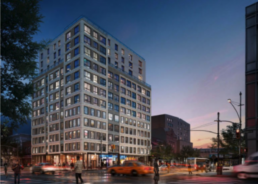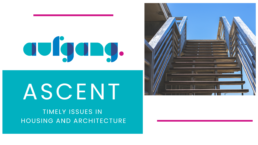A hotel row in Queens is getting a new look. New affordable housing is part of the mix
A hotel row in Queens is getting a new look. New affordable housing is part of the mix.
By Arun Venugopal
On a recent afternoon, sneakered tourists streamed out of the various hotels located along a quiet stretch of Jamaica, Queens. The Radisson, a Hampton Inn, a Residence Inn by Marriott, and erstwhile JFK Hilton just a stone’s throw from JFK Airport represent the future of affordable housing in the city, as well as what is perhaps a missed opportunity.
Months of interior demolition work is concluding at the 350- room Hilton property on 135th Avenue, just east of the Van Wyck Expressway. A massive renovation will soon follow. The structure is set to reopen in October 2025 — not as a hotel, but as a 318-unit housing complex for low-income and formerly homeless New Yorkers.
Creating kitchens in the studio apartments will be a challenge. There’s all sorts of weird esoteric rules in New York City about separating cooking spaces from living spaces, you shouldn’t sleep in a room where people are cooking. But aside from the technical hurdles, Aufgang said there are also grace notes, including the covered pool near the lobby that will soon be turned into a garden. It’s enclosed in glass, it’s going to be a lovely garden.
-Ariel Aufgang, the architect of the Aufgang Architects
The project, known as Baisley Pond Park Residences, is the result of a 2021 state law called the Housing Our Neighbors with Dignity Act, or HONDA. The measure was designed to convert hotels into housing. It took shape early in the pandemic, as the bottom fell out of the city’s hotel industry and tens of thousands of rooms suddenly became empty.

But nearly three years after its passage, housing advocates and others acknowledge that the HONDA program has little to show for it besides the Hilton project, which is being lauded for its planned amenities, services and design, and being lamented because it could very well be a one-off.
Top elected officials like Mayor Eric Adams and Gov. Kathy Hochul were among the project’s champions. In a December 2023 statement, the governor said the JFK Hilton’s transformation into housing would “help to bring our state one step closer to building the affordable, supportive and sustainable homes that New Yorkers deserve.”

“We had this massive window of opportunity,” said Amy Blumsack, the director of organizing and policy at Neighbors Together, which advocates for homeless and low-income Brooklyn residents, “and I think in some ways it was missed.”
The Hilton’s $167 million conversion is partly being paid for by $48 million in state funding – out of the $200 million allocated to HONDA. Housing and development experts say the program faced numerous challenges, including shifting market forces in the city’s hospitality industry spurred by the pandemic, red tape and opposition from unions, as well as insufficient political will to confront New York’s housing crisis. Its course was also affected by the migrant crisis, which started in 2022 as migrants were sent to hotel shelters by the busload.
“HONDA was started with all the good intentions,” said Vijay Dandapani, the president and CEO of the Hotel Association of New York City. But ultimately, he said, the funding was insufficient for the problem it sought to address. “It was not enough to move the needle.”
There are ‘all sorts of weird, esoteric rules in New York City’
Baisley Pond Park Residences will look out on a quiet residential neighborhood, half a mile from the airport. Despite its location near two busy highways and a bustling airport, the area has a placid, suburban feel. The sidewalks are noticeably clean and many of the houses across the street from the hotel sit behind white picket fences. Occasionally, an MTA bus stops nearby to let local residents off or take on tourists from the nearby hotels. The bus stop is conveniently located just 20 or 30 yards from Baisley Pond Park.
According to Slate Property Group, the private developer that acquired the property with its nonprofit partner RiseBoro Community Partnership, 274 of the 318 residential units at Baisley Pond Park will be studios, with 33 one-bedroom apartments and a smaller number of two- and three-bedroom units. Sixty percent of the completed units will be set aside for formerly homeless New Yorkers, while monthly rent for the remaining affordable housing units will range from $784 for a studio to $1,493 for a two-bedroom apartment.
But landing on a hotel property such as JFK Hilton – really any hotel that could be converted to housing under HONDA – wasn’t easy. David Schwartz, the co-founder and principal of Slate Property Group, said the company “looked at every hotel in the city,” but struggled to find sites with “a combination of good, decent rooms that are big enough for people to live in.”
Many potential sites were eliminated because their rooms weren’t big enough to include a kitchen, as is required under the NYC building code. Schwartz said other properties had big rooms but were situated within manufacturing districts, which meant they weren’t zoned for residential purposes. The ideal site, the company recognized, would accommodate at least 150 residents, which meant it could achieve economies of scale.
In many ways, the JFK Hilton, built in 1987, served the needs of the project. In addition to its size, the Hilton was blessed with “a huge lobby” and lounge, “so we have all this space to work with, which is really exciting,” said Emily Kurtz, the vice president of housing at RiseBoro Community Partnership.
The space allowed for the construction of multiple community rooms as well as a computer lounge and fitness room. In addition to staff tasked with onsite programming, there will be social services case managers. This is especially important, Kurtz said, given the population of many of the people who will be living at Baisley Pond Park.
“Residents will be coming directly from the shelter system, folks that have been in shelter for a while,” said Kurtz. “They’ll be provided permanent housing, with a key to a door, independent living and then supported by onsite supportive services staff.”
The entire project will take 21 months to complete, said Schwartz, versus the 36 months had it been a conventional ground-up construction, where the foundation alone might’ve taken six months to complete.
“It’s a lot less work,” said Schwartz, “and the beauty of the hotel rooms is that they all have windows to the outside and that’s really the trick is that they’re already set up. You have an elevator and stairs in the middle of the building, hotel rooms on either side. And it feels like an apartment building.”
Ariel Aufgang, the architect of the site, said creating kitchens in the studio apartments will be a challenge.
“There’s all sorts of weird esoteric rules in New York City about separating cooking spaces from living spaces,” said Aufgang. “You shouldn’t sleep in a room where people are cooking.”
But aside from the technical hurdles, Aufgang said there are also grace notes, including the covered pool near the lobby that will soon be turned into a garden.
“It’s enclosed in glass,” said Aufgang. “It’s going to be a lovely garden.”
‘The two puzzle pieces fit together’
The idea of turning the city’s hotels into affordable housing gained ground among policymakers and housing advocates early in the pandemic when tourism nosedived, leaving hotels sitting empty. Joseph Loonam, the housing campaign coordinator at Vocal New York, said “robust conversations” were happening by the end of March 2020, when the pandemic shutdown was kicking into high gear
“It was hugely exciting and it had incredible potential,” said Blumsack of Neighbors Together. “There were all of these empty hotels just sitting there and all of these people who needed a safe place to stay due to COVID.”
“The two puzzle pieces fit together,” she said.
But there were different ideas about how to move ahead. Samuel Stein, a senior policy analyst at the Community Service Society, a social welfare organization, urged the state to buy the hotels.
“That was the way that the (HONDA) legislation was initially drafted,” said Stein. “And the response we got from the state government was, ‘that’s not our role. We don’t want to be in possession of real property.’ There was very little appetite from that for anybody.”
Instead, HONDA stipulated that at least 50% of the units go to homeless New Yorkers and required a nonprofit organization to purchase the site, either by itself or in partnership with a private developer. The state allotted funding to assist in the purchase, initially a $100 million fund that was eventually doubled.
But even that amount was inadequate, given how expensive New York commercial real estate is, said attorney Daniel M. Bernstein, who runs the Affordable Housing practice at Rosenberg & Estis, a law firm specializing in New York City real estate.
Bernstein said that $200 million “sounds like a lot, but in the context of developing affordable housing for low-income households, it’s actually only a couple of buildings worth, depending on the scale of the buildings,” and added that he’s advised eight to 10 clients on the matter.
Some hotel owners thought the subsidy was inadequate, he said, while other properties ran up against zoning regulations that made it hard to convert to housing.
“There were just a lot of headwinds,” he said.
In a statement, William Fowler, a spokesperson for the mayor, said, “the biggest barrier remaining to pursuing more hotel and office conversions — and other kinds of housing development, big and small — is the city’s outdated zoning laws, which is exactly why we’re working to change them.”
According to Dandapani of the Hotel Association of New York City, the thousands of migrants placed into hotel rooms by the city artificially inflated the hospitality industry, making hotels less susceptible to market forces.
“There are at this point some 15,000 odd rooms that are being catered to the migrant,” said Dandapani. “It’s obviously temporary. Nobody knows precisely how long it would last, but that has taken this inventory out of the market and resulted in compression, whereby other hotels that are not catering to the migrants can have better occupancies and better rates.”
Eventually, Blumsack said, “the interest was just not as much as we had really hoped,” and as the worst of the pandemic subsided, tourists began returning to the city and its hotels.
For many housing advocates, Baisley Pond Park is the exception that proves the rule about HONDA.
“The JFK conversion is great,” said Joseph Loonam of Vocal New York. “But ultimately, there’s just not enough motivation on the developer and on the government side to really get units online.”
Believers among the skeptics
While HONDA left many housing advocates frustrated, some people continue to hold out hope for the program.
For instance, Dandapani said the situation could change if migrants currently being housed in hotels move out, leaving behind properties that require expensive improvements.
“Whenever the migrants exit the hotels, the condition of the hotels is going to require substantial, and you can underline substantial, FF&E: that’s furniture, fixtures and equipment upgrades.”
Additionally, in her new budget deal Hochul included tax breaks for developers who take on office conversions if they agree to make at least 25% of the units affordable.
And a spokesperson for New York State Homes and Community Renewal, the state agency that oversees affordable housing, said that at least two more hotels are likely to be approved for conversions.
“HCR continues to work closely with nonprofit partners throughout the state who are seeking to convert distressed hotels and underutilized commercial buildings to the safe, modern, and affordable housing New Yorkers need,” said Charni Sochet, a spokesperson for HCR.
Schwartz of Slate Property Group is decidedly bullish on conversions, and despite his company’s considerable efforts to find an appropriate site in the JFK Hilton, estimated “there certainly are dozens and dozens of hotels that could be good candidates” across the five boroughs.
He predicted that HONDA would eventually win converts.
“When you do something new and innovative with government, there are a lot of people waiting to see if you can be successful,” he said.
The proof, he said, rested in Baisley Pond Park.
“A year from now we’ll see more of these,” he said.
The pursuit of new housing via conversion

The pursuit of new housing via conversion
Converting underutilized hotels and office buildings to residential require different approaches
By Ariel Aufgang
Ariel Aufgang is principal of Aufgang Architects, LLC.
We face a national housing shortage, while commercial property owners and investors contend with an oversupply of empty office space, as well as underutilized — and closed — hotels throughout the United States. As a result, owners and developers are increasingly considering commercial-to-residential conversions as a way to solve both problems.
U.S. cities that lead in converting office space to residential are metro Washington, D.C., with plans under way to convert office space into 5,820 apartment units, followed closely by the New York City metro area, with 5,215 new apartments planned from former office spaces.
Nearly four dozen commercial buildings are enrolled in NYC’s Office Conversion Accelerator and are expected to comprise more than 2,100 housing units.
New York State enacted the Housing Our Neighbors with Dignity Act to encourage the conversion of hotels and other commercial buildings into affordable housing. Throughout New York State there have been successful commercial-to-residential conversions in Buffalo, Rochester, Syracuse and elsewhere. In Cohoes, N.Y., near Albany, Harmony Mills, a former textile industry site, was converted to apartments. In Albany, the old Union (train) Station is expected to be repurposed to residential.
There are a number of completed and proposed hotel-to-residential conversions in New York City. They include:
- The JFK Hilton Hotel
- Hotel Pennsylvania
- Paramount Hotel
- Best Western Hotel in Chinatown
- Towne Place Hotel in Queens
- Former Jehovah’s Witness’ hotel in Brooklyn
Also planned for a conversion to residential units is a vacant Sears Roebuck department store in Brooklyn and an office building at 25 Water St. in Lower Manhattan.
Hotels and office buildings present distinctly different issues to consider when evaluating the feasibility of potential residential conversion opportunities. Hotels have much different floorplans than office buildings, making hotel-to-residential conversion more practical and usually less costly. Multiple water and waste lines are already in place in hotels and can be modified relatively simply to convert a hotel building to apartment units. As a result, a hotel-to-residential conversion project can be completed faster and at a lower cost than an office building.
Hotel conversions are not without challenges. While some underutilized hotels are located in city centers, other potential conversion candidates are in less desirable locations next to airports or off major highways, far from residential communities — factors that can suppress the value and appeal of residential conversions.
Office buildings are usually located in city centers where many people work, with close access to public transportation, increasing their appeal as residential units, thus making them attractive to developers for conversion.
However, office-to-residential conversions often present costly design challenges. While office buildings often feature large windows not commonly used in residential design, they usually have deep footprints that deprive interior spaces of access to sunlight and outside air. This can be overcome through innovative design, such as creating an open core or atrium through the height of the building.
Also, elevators, stairways and systems such as water risers are usually centrally located in the cores of office buildings, requiring adding risers and lines to each new apartment unit. This increases conversion costs and lengthens construction time.
Commercial conversion to residential is a viable approach to increasing housing supply. Such adaptive reuse brings environmental benefits and makes financial sense.
These were the most active NYC architects in 2024

These were the most active NYC architects in 2024
By Holden Walter-Warner, Research by Matthew Elo
It’s been a chaotic year for New York developers and landlords — and as a result, for the city’s architects — with the real estate landscape being altered by state and city legislation, the whims of
office tenants and actions by the Federal Reserve.
Nikolai Katz Architect emerged as the most active firm of the year, in terms of its number of initial permit applications for projects above a certain size. With 15 such applications, it was one of only
three architects to hit double digits.
Many of Nikolai Katz’s projects were on the medium or small end of that spectrum. Other firms, such as SLCE Architects and Gensler, tackled fewer but larger projects. SLCE, for instance,
surpassed 2 million square feet across seven sizable projects.
The year was full of challenges for the industry. The interest rate environment remained largely unforgiving, the state replaced the 421a multifamily tax break with 485x and changed the rules for
office conversions, while the city passed its most sweeping zoning overhaul since 1961.
Meanwhile, development sites in New York City became even harder to find.
“The scarcity of parcels for multifamily real estate development is increasingly difficult,” said Ariel Aufgang of Aufgang Architects.
But there’s hope on the horizon. Architects contact by The Real Deal noted the significance of the City of Yes legislation, which loosened zoning restrictions and increased the density allowed for
multifamily developments.
TRD’s most active architects ranking for 2024 is based on the number of initial permit applications filed for new buildings and renovations. It reflects the architects of record on permit applications filed through Dec. 3 for projects of 10,000 square feet or more.
T-7. Aufgang Architects | 6 applications | 1.1 million sf
Ariel Aufgang’s firm has a hand in planning, designing and constructing developments across the tri-state region, and has appeared on year-end rankings for most active developers. This year’s filings included a 296,000-square-foot, mixed-use property in Brownsville and a 73-unit, mixed-use building at 132 East 125th Street in Harlem, which Maddd Equities is developing.
The firm recently launched a luxury division, Aurae, to meet what it sees as a growing interest in luxury multifamily developments and “bespoke individual homes,” accordin
AFFORDABLE HOUSING REQUIRES A NATIONAL COMMITMENT AND A CONVERGENCE OF URBAN PLANNING AND ENVIRONMENTAL RESILIENCY

Affordable Housing Requires a National Commitment and a Convergence of Urban Planning and Environmental Resiliency
A Federal Workforce Housing Czar is Crucial in Solving the Nation’s Housing Crisis
By Ariel Aufgang, AIA, Principal of Aufgang Architects
Despite universal recognition of an intractable national affordable housing crisis, not enough is being done to find and implement effective solutions.
According to JP Morgan Chase, “across the country, (housing) supply is scarce and prices continue to soar. Most people employed in full-time, minimum-wage jobs can’t afford to rent even a modest two-bedroom apartment—in any state in the country.”
The new administration in Washington, DC, has a historic opportunity to initiate effective new approaches to increase access to affordable housing. No specific policies have been revealed, but it is anticipated that the focus will be on the supply side. This is not surprising considering the real estate development background of the Chief Executive.
Solutions to this crisis require a multifaceted approach to overcome its deep-rooted causes. The new administration in Washington can get off the blocks quickly by making creation of workforce housing a national priority, with a determination comparable to landing Americans on the moon and bringing them safely home.
According to a recent analysis by the Center for American Progress, “Smart federal policy that addresses both housing and climate change is necessary to achieve a sustainable, healthy and inclusive economy that works for everyone… ”The appointment of a federal Workforce Housing Czar would be crucial in marshaling and focusing federal agency support and funding, coordinated with state and local initiatives. The Workforce Housing Czar would facilitate public-private partnerships comprised of private sector developers and financial institutions, nonprofits devoted to expanding affordable housing opportunities and government agencies at all levels. This must be done with the speed and scale required to achieve meaningful results.
It would ensure that the impact of existing programs is maximized by bringing together government, nonprofit and private-sector firms that are too often siloed. Chief among impediments to affordable housing development is NIMBYism, perpetuated by restrictive zoning regulations that limit multifamily density, and other provisions that inhibit development of affordable housing.
In New York State, while the Legislature has missed opportunities to address policy, programs and funding to significantly increase the supply of new and preserved income restricted housing, it did pass a State budget including the Governor’s ambitious plan to create half a million new housing units over five years.
In New York City the Mayor’s proposed “City of Yes” initiative would revise zoning codes to allow increased density and streamline the City’s slow and complex permitting processes that stall projects for years as their costs pile up. The New York City Council has come up with its own version of this proposed plan, which it may approve by the end of the year.
New York City rents have reached new historic highs in several boroughs. The gap continues to widen between housing costs and income. NYC households need at least $100,000 a year for food, housing and transportation. Families of four need fifty percent more. But the median income is $55,000.
To keep housing costs below the recommended 30% of income, the average New York City renter must earn about $134,000 per year. Yet about a third of New York renters spend more than half of their income on rent. This situation is unsustainable and jeopardizes the economic and social fabric of our communities.
Several states, counties and municipalities have begun using innovative approaches to encourage and incentivize affordable housing development and preservation. Many of these provisions call for financial consequences on jurisdictions and developers that refuse to comply, applying a carrot and stick approach.
In Florida, for example, new regulations aim at clearing away impediments to the creation of much needed workforce and affordable housing. New state laws there are specifically designed to ease density restrictions and overcome political resistance that sustain NIMBYism in counties and towns across the state, while at the same time providing financial incentives to encourage communities to allow the development of affordable housing.
Florida’s Live Local Act addresses the state’s entrenched affordable housing crisis. Enacted in July 2023, it facilitates denser housing development on cheaper land, chiefly by limiting the authority of local governments to block affordable housing with zoning and density regulations.
The Live Local Act permits construction of multifamily housing on any commercial parcel if enough of the units are dedicated to affordable or workforce housing. Developers in Florida are now able to use the maximum zoning allowed within a one-mile radius of the site, without having to contend with protracted and costly rezoning applications.
Such creative regulations expand income restricted housing supply by boosting funding for housing and rental programs, adding incentives for housing investment and encouraging mixed-use development in financially distressed commercial areas. Also, in this high-interest rate environment faster zoning and building permit approvals reduce interest costs, thus allowing the creation of more affordable units.
The Live Local Act requires that local governments in Florida must approve–without public hearings, a rezoning process, or land use change requirements–housing development on sites zoned commercial, industrial or mixed use, if at least 40 percent of the residential units are affordable for at least 30 years to households making a maximum of 120 percent of the area median income. It also reduces local authority to impose density and height limits. There are few other restrictions. The market rate units can be rental or condo, and they may be separated from affordable units.
This innovative approach by the state is encouraging counties and municipalities to also act on their own to revise zoning regulations in harmony with new statewide programs, amplifying the impact of income restricted housing development programs.
Florida is not alone in coming up with creative approaches to increase the supply of affordable and workforce housing. Successful programs are underway in California, in the Los Angeles and Bay areas, as a well as in Colorado and in towns in Westchester County, NY, and other states.
Harnessing America’s awesome collective talent and resources in finance, architecture and urban planning, commercial real estate development and public and social policy, requires clarity of vision and the political will on the part of our elected officials to quickly address our affordable housing crisis through new policies and programs.
Discussions of affordable housing development must also address the roles of urban planning and environmental sustainability which overlap to a meaningful degree.
According to archeologists, urban planning may date back to the Mesopotamian civilization. It is recognized that the ancient Egyptians utilized rudimentary urban planning techniques, and there is no question that the Romans took sophisticated approaches to urban planning. These include the utilization of wetlands to drain off tidal flooding from low lying cities, including Rome, and impressive infrastructure including the famous Roman aqueducts and laying out city streets to facilitate regular large deliveries of agricultural and other goods.
Cobblestone roads around the Imperial Roman Forum are rutted from the wheels of carts that delivered heavy loads of agricultural products brought to shops and markets in the city.
Today, modern environmental sustainability combined with urban planning can be seen in Edgemere Commons under construction in New York City. Developed on more than 9 acres in the Rockaway Peninsula in Queens, it is a 100% affordable planned community of 11 buildings with over 2,000 units in an area historically vulnerable to tidal flooding, especially when driven by hurricanes, which are occurring with greater frequency and intensity. My firm, Aufgang Architects, created an urban plan for Edgemere Commons, and designed individual buildings in that community. The features we specified to improve environmental resiliency ranged from raising mechanical systems above flood levels, directing storm water to run off into wetlands and incorporating green roofs to reduce heat island effects. Our urban planning for Edgemere Commons also includes features that improve the quality of life for its residents, such as inviting walkable paths with attractive trees and plantings and benches in central gathering places that increase outdoor social contact among residents.
Another impressive example that combines urban planning with robust environmental resiliency is Babcock Ranch near Ft. Myers, Florida, which suffered little damage when Hurricane Milton rushed ashore earlier this year. Babcock Ranch was designed to withstand increasingly fierce storms. (My firm was not involved in the design of Babcock Ranch.)
Babcock Ranch prioritizes sustainability and resiliency, featuring walkable villages that foster a strong sense of community.
All of the structures at Babcock Ranch are built to withstand 150 mph hurricane force winds. Its 150-megawatt solar farms and underground transmission system ensure the community rarely loses electricity. Nearly 90% of the site is preserved wetland that helps collect excess water.
The United States is the first and only country to land men on the moon and bring them back. That was over a half century ago and resulted from a national commitment. Today we face new challenges here at home. The same energy, focus and determined national commitment must be applied to expanding access to safe, comfortable and resilient housing for all Americans. We have the ingenuity, treasury and drive required to achieve this crucial goal.
For additional information: www.aufgang.com/
NEW AFFORDABLE MULTIFAMILY MIXED-USE CONDO IN THE HEART TO HARLEM TO BRING HOME OWNERSHIP OPPORTUNITIES

New Affordable Multifamily Mixed-Use Condo in the Heart of Harlem to Bring Home Ownership Opportunities
A 73-unit affordable mixed-use condominium will be constructed at 132 East 125 Street at Lexington Avenue, bringing home ownership opportunities to the heart of Harlem.
Developed by Maddd Equities and designed by Aufgang Architects, the 13-story building will include 7,000 square feet of ground floor retail space and 45,000 square feet of medical offices on the second through fifth floors.
“We are pleased to enable affordable home ownership at one of the most vital intersections in Harlem,” said Ariel Aufgang, Principal of Aufgang Architects. “Homeownership strengthens the economic and social fabric of communities.”
“The new condo will feature larger apartments than usually found in new affordable residential construction in Manhattan, as well as an array of energy saving and environmentally sustainable features,” said Aufgang. “The new Harlem condo will provide residents with many appealing amenities.”
Of the 73 condo units, 31 will be 1-bedroom, 38 will be 2-bedroom and 4 3-bedroom units.
The development will meet HPD Homeownership Program guidelines for affordable condos, which calls for larger units than other programs. The units will be approximately 100 square feet larger than other HPD affordable programs.
Key features include:
- The building will be all electric, in compliance with Enterprise Green Communities criteria.
- Outdoor recreation space along with a fitness center and co-working space/lounge.
- Residents’ quiet enjoyment of their homes will be enhanced by the installation of window/wall noise attenuation materials and alternate means of ventilation.
“The anticipated approval of the City of Yes, providing measures to develop additional affordable housing throughout the City, underscores the importance of first in class affordable homeownership, such as this multifamily project in Harlem,” said Aufgang.
In the past 22 years Aufgang Architects has designed more than 14,000 units of affordable housing and 20 million square feet of built space.
Aufgang Architects is a certified Minority Business Enterprise.
Bespoke and Luxury Lifestyle Designs
Bespoke and Luxury Lifestyle Designs
The Aurae team creates elegant designs for vibrant lifestyles, from single family homes
to entertainment and housing complex master plans.
Intern
Planning and Community Development
Year Joined: 2023
Education and Certifications:
- Degree in Architecture, City Tech (CUNY) 2026 (in progress)
Professional Background: Ziani learned about Aufgang through the class that our Director of Planning and Community Development Shiva Ghomi teaches: “Sustainability: History and Practice”. In learning about our firm, she discovered that Aufgang designed the building she lives in.
Position: As part of our Planning and Community Development team, Ziani spends a lot of time preparing zoning and feasibility studies. She has also gotten the opportunity to go on site visits and explore other departments in the office. Ziani believes that architecture is an overlooked way of helping people. She sees it as an opportunity to do a public service job and have a positive impact on people’s everyday lives.
Personal Life: In the future, Ziani wants to get a Master’s Degree in urban planning or environmental studies.
Ziani Rodriguez

Ziani Rodriguez
Intern
Planning and Community Development
Year Joined: 2023
Education and Certifications:
- Degree in Architecture, City Tech (CUNY) 2026 (in progress)
Professional Background: Ziani learned about Aufgang through the class that our Director of Planning and Community Development Shiva Ghomi teaches: “Sustainability: History and Practice”. In learning about our firm, she discovered that Aufgang designed the building she lives in.
Position: As part of our Planning and Community Development team, Ziani spends a lot of time preparing zoning and feasibility studies. She has also gotten the opportunity to go on site visits and explore other departments in the office. Ziani believes that architecture is an overlooked way of helping people. She sees it as an opportunity to do a public service job and have a positive impact on people’s everyday lives.
Personal Life: In the future, Ziani wants to get a Master’s Degree in urban planning or environmental studies.
Michael Battipaglia

Michael Battipaglia
Job Captain
Architecture
Year Joined: 2024
Education and Certifications:
- Associate’s Degree in Business Administration, SUNY Orange
- Bachelor of Arts in Environmental Design, University of Buffalo
- Master’s Degree in Architecture, Tulane University
- Currently working towards obtaining full architecture license
Professional Background: Prior to Aufgang, Michael spent three years working at Paul Bennet Architecture, where he worked on high-end commercial and luxury retail. His role sent him across the country to conduct site surveys and punch lists. After that, Michael joined Rawlings Architects, a firm that focused on new construction of residential high rises and New York City school projects. There he gained experience at all phases of a project. He also produces shop drawings for a high-end metal fabricator in Baltimore, MD.
Position: Michael’s position includes production of construction documents, collaborating with consultants in the construction administration phase, and handling the day-to-day needs of an active project.
Personal Life: Michael has skills in carpentry and historic home renovation and enjoys spending time outdoors with his two children.
Hugo Subotovsky

Hugo Subotovsky
Retired Principal
Years at the Firm: 1988 to 2012
Education and Certifications:
- University of Buenos Aires, School of Architecture, 1980
- Registered Architect in New York
Professional Background: The firm was originally established in 1971 by Jacques H. Gerstenfeld A.I.A. Hugo S. Subotovsky joined the firm in 1987 and became a partner in 1997. During the time of his partnership, the firm was known as Gerstenfeld-Subotovsky Architects. In 1999, Jacques H. Gerstenfeld retired from the firm, and in 2000 the firm changed its name to Hugo S. Subotovsky A.I.A., Architects LLC. After Ariel Aufgang became a partner, the firm’s name again changed to Aufgang Subotovsky Architecture & Planning (ASAP). During his time as Principal, Hugo grew the firm’s expertise in new construction of commercial/retail structures, new residential multi-family structures, mixed use buildings, and rehabilitation of existing residential structures. His team excelled in navigating the complexities of a large project with multiple land use actions required and completed large rezonings with street mapping applications.
CAN PEDESTRIANS AND BICYCLISTS SAFELY COEXIST WITH MOTOR VEHICLES ON COMPRESSED CITY STREETS?

Can pedestrians and bicyclists safely coexist with motor vehicles
on compressed city streets?
Pedestrians and cyclists are threatened by cars, buses and trucks in compressed traffic on city streets. How can urban planners solve this life and death problem? One answer may be found in Europe where the Netherlands has redesigned some city streets to provide a smoother and safer flow of people and motor vehicles. A traffic system, called “woonerf,” which means “shared space” in Dutch, blurs the barrier between street and sidewalk.
“Rather than one standard design, the system has many shared common elements,” says Vivien Ferrari, Senior Designer, Planning and Community Development at Aufgang. “Some have no curbs between areas for people and cars. Others may feature cobblestone or similar rougher road surface materials to encourage drivers to slow down and be more alert and cautious about pedestrians and cyclists.”
This system offers an array of potential benefits:
- Most importantly, slower, smoother traffic flow makes streets safer for close sharing among motor vehicles, pedestrians and cyclists.
- Retail stores may see an increase in business when it’s easier for shoppers to walk around a commercial area.
- More street space can be used to plant trees and other landscaping, beautifying urban areas.
- It can create public gathering spaces that enable social activities and cohesion and strengthen neighborhoods.
- Ideally, dedicated bike lanes lower individual use of cars and reduce traffic congestion.

Can such a pedestrian-centered infrastructure “work” in New York and other large American cities? Some steps can be taken to apply these principles, says Vivien Ferrari. “I would propose adding bike lanes to existing roads along with very clear signage. A series of barriers and distinct road and lane colors will also help to safely separate bike lanes from vehicular traffic. In areas with wide sidewalks, we would incorporate sitting areas and planters where space and property lines allowed.”
There are cultural, scale and infrastructural differences in the U.S. that may reduce the appropriateness and effectiveness of the Dutch system, starting with European drivers’ respect for the need to safely share streets with cyclists.
The COVID-19 pandemic brought a decrease in both vehicular traffic on New York City streets and reduced ridership on the subway and buses as many people worked remotely from home. This has turned around. Traffic is heavier and commuter ridership has substantially grown on public transportation, nearing pre-pandemic levels.
And there are many more pedestrians and cyclists on city streets which unfortunately has brought an expected increase in injuries and fatalities resulting from accidents with cars, trucks and buses. Adapting a European solution to New York and other American cities requires more than changing traffic flows on redesigned urban streetscapes, warns Aufgang’s Vivien Ferrari.
“It will also require a cultural shift based on educating drivers, pedestrians and cyclists,” she says.


